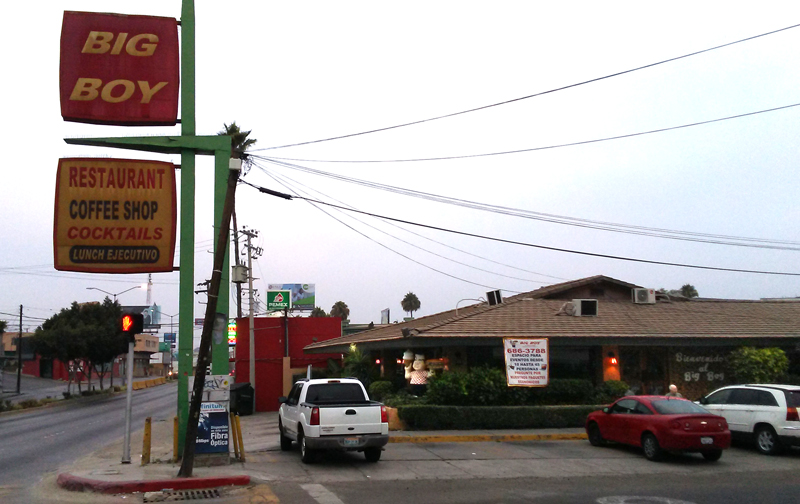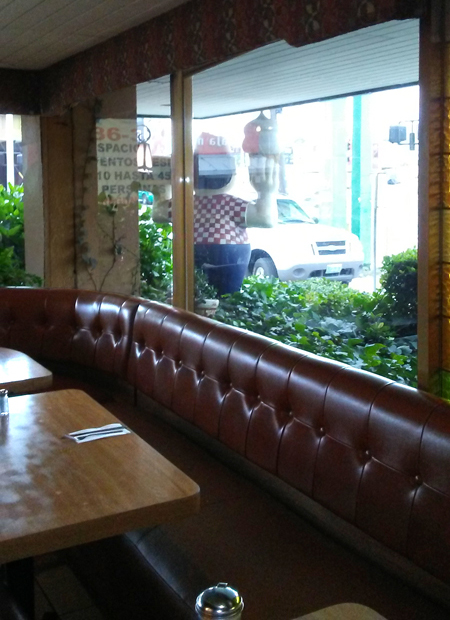|
Tijuana's Big Boy: Iconic Hangout Turns 45
September/October 2017
By Maria E Curry
 Tijuana's historic Big Boy restaurant, an icon of car culture, turns 45 this year. |
 The iconic Big Boy statue seen from inside the Tijuana restaurant. Photos courtesy Maria Curry |
The architectural history of Baja California and California is closely linked. Transborder expressions of car culture, from the 1950s to the 1970s, include neon signs, drive-in restaurants, coffee shops, gas stations, motels, and trailer parks. Many of the builders of these enterprises were Americans who partnered with Mexicans. A still thriving, prominent example: Tijuana's Big Boy, built in 1972, by Californian Raymond Eugene Zivelonghi, in remembrance of the Big Boy hamburger chain he visited as a child, and by Tijuana carpenter José Luis Barajas.
Zivelonghi (1931-2011) was born in Sierra Madre, California to Italian immigrants. He studied business administration during the mid-1940s and in 1953 worked as a set builder for 20th Century Fox Studios. He married Carmen Melgarejo Miranda, a Mexican, in 1958. The couple moved to Acapulco the next year, when resort hotels and restaurants were booming. Along with some friends, they acquired the rights to the Big Boy trademark for a franchise.
The Zivelonghis built a Big Boy restaurant in Acapulco similar to the Denny's with a boomerang roofline on N. Mollison Avenue in El Cajon, California. Its open-air design allowed casually attired customers to come in off the beach and enjoy a hamburger, fries, and a milkshake. This building had a big sign at the corner and a statue of a boy holding a hamburger in his left hand and an ice cream cone in his right, resembling the 1956 Big Boy trademark.
In the 1960s, they opened three more restaurants in Acapulco, one of which was another Big Boy. However, as a result of Mexico's social turmoil at the end of the decade, the Zivelonghis decided to move back to California.
Riding the wave of new fast food outlets and car culture, Zivelonghi and his brother-in-law opened a hot dog restaurant and Hugo's Burgers in Pasadena. Hugo's fell to competition from McDonald's and Carl's Jr.
The Zivelonghis opened two Big Boy restaurants in Tijuana in the 1970s with a partner. Today the Zivelonghi family is the sole owner of the remaining one, which still serves the famous double-decker hamburger along with Mexican dishes.
Tijuana's Big Boy, at 9892 Agua Caliente Boulevard, stands across from the site of the former bull ring, demolished ten years ago, and a few blocks from the remains of Agua Caliente Casino and the Caliente Race Track. This major boulevard connects with Avenida Revolucón and the old Ensenada road, and Big Boy's corner location attracts the attention of drivers passing by.
In its best years and to some extent to this day, the bustling restaurant is where business people, politicians, police officers, and journalists rub elbows, discussing the city's social, political, and crime-related matters. Old Tijuanenses still gather here, including Rodrigo Barajas, a 90-year-old ex-union leader and brother of José Luis Barajas, the carpenter who built the restaurant. José Luis also built another, smaller restaurant on Boulevard Insurgentes called Bad Boy, a smaller version of his Big Boy.
Tijuana's Big Boy's architecture is Modern Ranch combined with contemporary post-and-beam wood construction. The building is distinguished by a low-pitched, overhanging roof, and long, low masonry planters that add horizontal emphasis. The façade includes wood cladding, concrete, and tile, and large fixed windows.
The recessed main entrance welcomes guests with a sign: "Bienvenidos al Big Boy." The signature 4-foot statue of Big Boy stands at the corner, with a tall sign visible to drivers stands in front of the statue. Its green, yellow, and red design is Googie style with Space Age influences.
The restaurant interior is furnished with leather-upholstered booths and laminate tables. Exposed wood ceiling beams and huge iron chandeliers create a cozy atmosphere, despite the conventional drop ceiling. According to waiters who have served thousands of burgers over 30 years there, the original 1972 design is mostly intact.
Tijuana's Big Boy is more than a baby boomers' bit of nostalgia. It's a 45-year-old monument to international car culture and the enterprising cross-border romance of an Italian-American and his Mexican bride.
|
2024
2023
2022
2021
2020
2019
2018
2017
2016
2015
|





